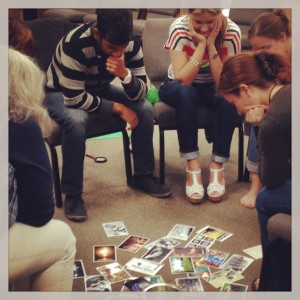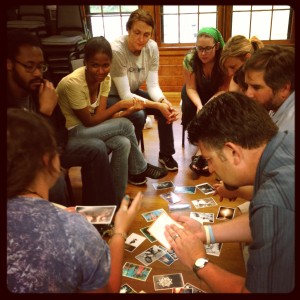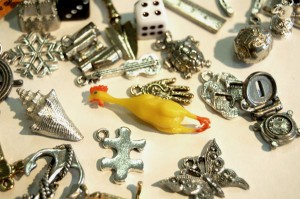Aug 22, 2013 The Power of Using Objects, Pictures, and Other Metaphoric Methods in Teaching and Group Facilitation
 My summer travels forced me to take a break from the blog. Today I’m inspired to write again after reading Adam Clark’s comment on my June post about “Making the Most of Transitions”.
My summer travels forced me to take a break from the blog. Today I’m inspired to write again after reading Adam Clark’s comment on my June post about “Making the Most of Transitions”.
“Great post here with lots of useful suggestions for transitions! Even though we are now entering into our beginning of year activities I think a number of them can be tweaked just a little to help there, too. I was thinking that for my new students I might have them write a postcard to themselves at the end of their first semester. I’m thinking this will help them see past the initial hurdles to the point where they are settled and content. Sometimes just having the vision of good outcomes is all that is needed to help them manifest. – Adam“
As I facilitate back to school trainings and fall program start up sessions I am pulling out the postcards, my Miniature Metaphors, and other metaphoric tools again to kick off programs. Image cards, postcards, artwork, and tangible objects can be used as meaningful and engaging tools for facilitating introductions, inspiring reflection, goal setting, creating group norms, resolving conflict, and celebrating strengths. These methods add a depth and character to reflection in a way that doesn’t happen with dialogue alone. In this post I thought it important to explore WHY these methods are so powerful for sparking meaningful group discussion and reflection:
Interesting objects and images capture participant’s attention and draw them into an experience or reflective discussion. Often people can more easily express themselves and their thoughts through an object, symbol, or picture than through verbal means alone. People have the tendency to share more deeply when they have a visual symbol or object to represent or attach to their thoughts and feelings that can be touched and shown to a group during a discussion. These methods are less threatening to many people than verbal focused discussions or question answer sessions because the participants can talk about the object or image rather than about themselves, or their feelings directly. With these methods more introverted group members are able to express thoughts, or share feedback or insights that otherwise might be left unsaid. Brain research suggests that using metaphors, pictures and symbols helps cement lessons and transfer learning to everyday life and future learning (Willis, 2006, 2010). A visual representation of an experience can be effective long after the experience is over, reminding a group or participant of the key lessons learned.
 A benefit of these object and image based methods is that they are “participant centered”. These approaches put more control on the learner or the group for interpreting their experience, feelings and goals rather than the group leader directing and possibly inserting their own interpretation or agenda. This allows for spontaneity in reflective discussions and possibly a deeper connection to the learning experience. Many educators use our postcards, image cards and objects to inspire creative writing, as journaling prompts or as a tool for exploring metaphor and figurative language in the classroom.
A benefit of these object and image based methods is that they are “participant centered”. These approaches put more control on the learner or the group for interpreting their experience, feelings and goals rather than the group leader directing and possibly inserting their own interpretation or agenda. This allows for spontaneity in reflective discussions and possibly a deeper connection to the learning experience. Many educators use our postcards, image cards and objects to inspire creative writing, as journaling prompts or as a tool for exploring metaphor and figurative language in the classroom.
Here are a few of my favorite ways to use postcards or objects for introductions, for transitions and to inspire reflection:
To Begin a Group or Facilitate Introductions and Goal Setting
Spread postcards or objects out so they are accessible to all group members. As they enter the room for group or class ask participants to choose a card that represents answers to questions such as:
- What is a goal you have for the program?
- What are your expectations for the day?
- What is a unique perspective you bring to the group or program?
Having the cards or objects available during pre-group gathering time or as an entry activity can sparks conversations, helps group members get to know each other, and sets the tone for the program. Choosing a card or object gives people something to focus on as they transition into the workshop or classroom space.
Try posing a question related to the group’s purpose for coming together. For example, when leading a program with a group of teachers you might ask participants to choose a card that represents one of these ideas:
- The reason you are drawn to teaching
- A card that represents a quality you think is most important in a leader
- A strength you bring to your work
- A hope you have for the upcoming school year
 Processing or Reflection Activities
Processing or Reflection Activities
Individual Reflection Methods
- Have participants choose a card or object that represents their role or unique perspective
- Ask them to reflect on a lesson learned or write about how the card or object represents the lesson or a personal goal or commitment.
- “Postcard to Carry Learning Forward” As described in my June post consider asking participants to choose a card that represents a lesson they learned or a personal goal they want to be reminded of. Have them self-address the card and then write about that lesson and a commitment to themselves on the card. Then send it to them as a reminder/memento a few months later.
- Postcard/Object Strength Activity (see my March, 2013 post for more ideas on celebrating strengths)Have individuals choose a card or object that represents a personal strength. You might have participant’s journal about their objects/cards or if you are using postcards write a commitment on the back for later. For groups who work together closely or know each other well instead of having individuals share why they chose their object or card to the group ask them to hold up their card or object while their colleagues guess why they picked it. With this method the participant gets to hear some positive insights, complements and feedback from their peers (something many people don’t get enough of in their school or work lives).
To Stimulate Group Dialogue and Reflection
- Ask the group to come to agreement on one card/object that represents what the group has achieved together
- As a closing activity/or as a “check in” halfway through a program have the group pick three to tell a story of where they started, where they went and where they hope to go next
To process or reflect in the middle of an experience you could integrate the objects or images into the activity itself to represent goals or obstacles, or as a tool to tell the story of their journey through the activity see my 2010 post “Processing in the Middle of the Experience”.
For Group Goal Setting or Group Norms Discussions:
- Ask group members to work together to choose a card or object that best represents one of the following ideas:
- What they want to achieve together
- A symbol of the group’s strengths and purpose
- The specific group norms or ideal behaviors, characteristics they would like to ensure are present in their group.
Resources
Create your own image kit from magazine pictures or postcards or “junk” from flea markets. To purchase a “Pick -a-Postcard” or “Miniature Metaphors” kit contact jen@experientialtools.com or click here for our store.
References
Stanchfield, Jennifer. 2007 Tips & Tools for the Art of Experiential Group Facilitation. OKC, OK Wood ‘N’ Barnes Publishing.
Stanchfield, J. 2001. Adventures in Learning: Methods and Materials for Aiding Teachers in the Implementation of Experiential Education Curriculum Minnesota State University, Mankato
Cain, Cummings Stanchfield, 2005 A Teachable Moment: A Facilitator’s Guide to Activities for Processing, Debriefing and Reviewing and Reflection. Iowa Kendall Hunt Publishing.
“Understanding by Design Meets Neuroscience: Teaching to the Test and Rote Memory Tests as Measurement of Achievement are Not Neuro-logical for Successful, Joyful Learning” 2011 Learning and the Brain Conference Boston.
Willis, Judy. (2006). Research-Based Strategies to Ignite Student Learning. Alexandria, VA:ASCD



Kelly Cook
Posted at 18:01h, 23 AugustThanks for such an inspirational class in Madison this summer. After spending time with your objects, postcards, and toolbox, I went through my ‘collections’ and was surprised at how much I could use. It will be fun to try them out in my 9th grade science classroom. Hope to see you and give you an update in Denver.
Thanks again!
Jen
Posted at 04:20h, 05 SeptemberKelly,
You are very welcome. I truly enjoyed spending the week with you all. What a thoughtful group of educators! I am glad you are feeling inspired to use your collections. I would love to hear how it is going!
Jen